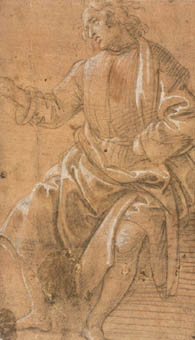Filippo Lippi Drapery study (s/p c. 1450)
Lippi Seated Man silverpoint c1485
Filippino Lippi
Seated Man Raising His Right Arm
1485 – Metalpoint heightened with white on prepared paper – 170 x 99 m m
Filippino ‘s graphic oeuvre includes a large number of figure studies, both draped and nude. They are often drawn two or three to a sheet, but the figures are generally unrelated to one another and, in the past, many sheets have been dismembered in order to create self – sufficient drawings. These studies are almost always made in metalpoint with the addition of white body color on prepared paper. Filippino used different colors for his grounds: often blue, gray, or blue – gray but also light brown and salmon – pink. Few of his studies of this kind can be connected with specific projects, and it seems clear that he and members of his studio made them to practice the representation of the movements both of nude and draped figures and of the expressive potential of drapery forms. Filippino ‘s draperies are often of extraordinary complexity and vitality, and it is evident that he was fascinated by the activity of the inanimate, which can sometimes impart a wave – like motion to his compositions. Filippino, indeed, is one of great exponents of movement in the later quattrocento. But, unlike his master Botticelli, he employs it less for concentrated and explosive dramatic purposes than in the service of an all – pervading agitation. In this respect he anticipates elements of the later style of Giulio Romano, who was surely aware of, and responded to, this and other aspects of Filippino ‘s work.
The present drawing, however, is less complex in its pose and drapery forms than many of Filippino ‘s metalpoint figure studies. That may be the reason it was re- attributed by Berenson to Davide Ghirlandaio in 1903, although Gonse gave it to Filippino in 1877. It was returned to Filippino only in 1956, following an opinion expressed by Popham in a communication to the Mus'e de Lille in 1948. As noted by Goldner in 1997, it is very close in type and style to a drawing in Frankfurt (Fig. 4) that is similar in size, on paper prepared with a related if not identical color of ground, and looks to have been drawn from the same model. The two sheets could well have originated at the same session. They probably date from the first half of the 1480 s; their forms have a Masaccesque substantiality, which intimates they were drawn not long after Filippino had completed work on the Brancacci chapel. No suggestion has been advanced as to the purpose of the two drawings, and they, too, may be no more than exercises. However, the pose in the present drawing, although not that of the Frankfurt work, would be suitable for Christ in a composition of Christ crowning the kneeling Virgin. Indeed, it is not unlike that employed by Raphael and his school in the Monteluce Coronation (Pinacoteca, Vatican City) as it was completed in 1524.

